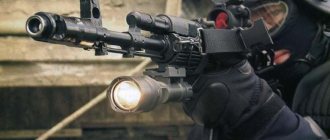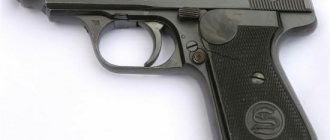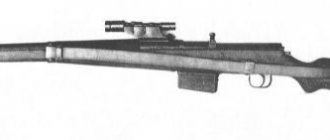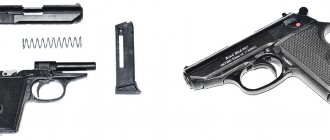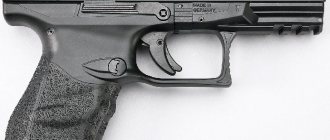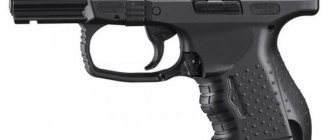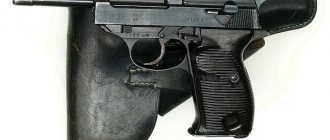Walther P38 pistol, manufactured during the war at the Mauser-Werke plant. Despite the fact that firearms are constantly evolving, some of their models have remained consistently popular for many decades. One example is the German Walther P38 pistol, developed before the outbreak of World War II. Until now, these weapons are stored in Bundeswehr warehouses, and, if necessary, can be “mobilized” for use for their intended purpose. In some third world countries, for example, in Afghanistan, the Walter P38 pistol has even become a kind of symbol of social status: its possession is considered honorable. It should be noted that at one time it was quite difficult for the creators of these weapons to achieve success. The designers had very little time, and they needed to prove that the new pistol would be better than its “predecessors,” which already had an enviable reputation.
History of the development of the Walther P38 pistol
In 1933, Adolf Hitler, a politician who never hid his revanchist aspirations, became German chancellor. Quite quickly, he turned into a dictator, announced Germany’s refusal to comply with the restrictions imposed on it by the Versailles Peace Treaty, and began to prepare the country for a new war. The army, which until recently numbered only one hundred thousand people, was to become massive again. This, of course, required a large number of weapons, including pistols.
Walther P38 and its main competitor, Luger P08 Parabellum
In the mid-30s, the two most famous German pistol models were the Mauser C96 and the Luger P08, which was often called the Parabellum. Despite the fact that the Mauser had already become a real legend, it was categorically not suitable for mass armament: it was too large, bulky and at the same time very expensive. “Parabellum” was also neither cheap nor technologically advanced, nor simple in design. Another weapon was needed, and it was offered by Carl Walther Waffenfabrik GmbH - not to be confused with Walter AG, which specializes in the production of metal working tools.
Previously, this company was known mainly for its “police” pistol. Created back in the 20s, the 7.65 mm Walter PPK was not only effective, but also a very beautiful weapon. Of course, the future “James Bond pistol” was not suitable for the army, since it used insufficiently powerful ammunition. Nevertheless, at first the designers believed that they could use this model to create an army model chambered for 9x19 mm cartridges.
In 1935, the Walther MP (Militar Pistole) was demonstrated, which was very similar in appearance to the enlarged and weighted Walther PP pistol. Already the first tests showed that the automation, created on the basis of a freely moving bolt, does not cope with its tasks due to the significant loads created when firing powerful 9x19 cartridges. To become reliable, such a pistol would have to “gain weight,” which was contrary to the technical specifications.
Walther MP pistol. Reminds me of an exaggeratedly enlarged "Walter PP"
It was decided to turn to an automatic circuit that works thanks to the short stroke of the barrel during recoil. The same operating principle was used, for example, in the creation of Parabellum. But if in the P08 the barrel bore was locked using a rather complex system of levers, then the designers of the Walther company used the invention of Fritz Bartlemens, who developed the so-called swinging cylinder. This part, moving in a vertical plane, ensured both reliable locking and disengagement of the bolt group and barrel when rolling back.
In 1936, the Walther AP pistol (Armee Pistole) was demonstrated to representatives of the Wehrmacht. The introduction of a new locking mechanism not only ensured reliable operation of the automation, but also gave the pistol a very distinctive appearance, completely different from previous “police” models. One of the features of this version of the weapon was the absence of an external trigger. It was this detail that the military did not like, who showed a certain conservatism in this case.
The following year, 1937, the Walther company demonstrated a pistol with an open hammer, designated HP (Heeres Pistole). This model won competitive tests, where it competed with samples prepared by such well-known companies as Sauer & Son and Mauser-Werke.
Walther AP pistol. It is easy to distinguish - there is no external trigger
As a result, it was decided to adopt the Walter pistol, but only after making a few more changes. The final version, designated Walther P.38, that is, model 1938, differed from the HP modification in the design of the trigger and the safety mechanism.
Serial production of the new pistol began in 1940, however, at first there was no need to talk about mass production. Meanwhile, the need for these weapons was rapidly increasing, since large-scale hostilities had already unfolded in Europe. Unable to increase its own machine park, the Walther company was forced to transfer the pistol drawings and all other technical documentation to yesterday's competitors - the Mauser and Spree-Werke companies. In addition, the production of individual parts was launched in the occupied countries - Belgium and Czechoslovakia. All these measures made it possible to significantly increase the number of Walter P38 pistols, but it was not possible to completely oust the Parabellum from the army.
After the end of World War II, the Walther company ceased to exist. The victorious countries took the production equipment (some of it went to the USSR). At the same time, the production of the Walter P38 pistol continued for some time, only now for the needs of the French army and the Czech police.
The post-war Walther P1 is very difficult to distinguish from the P38, you have to study the markings
In 1955, a new army known as the Bundeswehr was created in western Germany. The revived company Carl Walther Waffenfabrik GmbH, realizing that the armed forces, as before, would need pistols, immediately remembered its previous developments. Bundeswehr officers received the Walther P1, which differed from the wartime models in its aluminum frame. At the same time, for the needs of the police, the pistol was produced under almost the same designation - instead of “P.38” simply “P38”.
Today, the Walter P38 formally remains in service with the Bundeswehr, although since 1997 it has been actively replaced by the Heckler & Koch USP pistol (known as the P8). Significant quantities of these weapons are also available in other countries.
History of creation
The 9 mm Walther PPK pistol was created on the basis of the Model PP pistol by Carl Walther GmbH Sportwaffen, released in 1929. Since 1908, Walther had produced several semi-automatic pistols that had a reputation for being well made and reliable, but the PP was an important step in a new direction.
As the name suggests, it was designed to be carried by police officers and was based on the differences in attitudes towards police weapons across continents. While Americans preferred relatively large-caliber revolvers, Europeans chose smaller, lighter pistols more suitable for densely populated cities.
The PP model was one of the first pistols to be made from alloy rather than steel, allowing for significant weight savings. This solution was appreciated by experts, but the police needed a smaller version that could be carried discreetly by plainclothes officers and undercover detectives.
The result was the Walter PPK (Polizei Pistole Kriminal or Police Detective Pistol).
Design Features
Despite the fact that one of the goals pursued by the developers of the Walther P38 was to create a weapon that was simpler in design than the Parabellum, they only partially succeeded in achieving this. There are 58 parts in the design of the pistol, which in itself is a lot, and many of them are quite small. The number of springs is 11, and this is even more than that of the Luger P08, which has 7 of them. The trigger mechanism is also no different in its simplicity.
Disassembled Walther P38 pistol. Many small details surprise those who are accustomed to weapons of a simpler design.
The pistol's magazine is small by modern standards: it holds 8 rounds. There are two return springs; they are located under the bolt, on the sides of the frame. Above the trigger you can see a small rod - this is an indicator that allows you to determine whether the gun is loaded or not. In the first case, the rod will be extended. There is a fuse on the left side of the bolt. When it is turned on, the trigger can be pulled - the firing pin will be separated from it and the shot will not fire.
The pistol sight is constant, of the simplest design. The weapon is not designed to fire more than 50 meters.
Disassembly
Complete disassembly of the Umarex Walther CP88 Competition Black is very difficult. If you are not a jack of all trades, then settle for a jack of all trades.
Partial disassembly of the pistol occurs in the following order:
- Pull the receiver lever down to open the charging chamber.
- Push the receiver back a little, but so that it does not snap back.
- Insert a long flathead screwdriver into the hole in the attachment under the barrel and remove the screw.
- Remove the plastic nozzle. If desired, it can be disassembled (two screws on the right).
- Remove the receiver, the weight with the guide and the spring on it.
- On the left front, find the small screw securing the barrel and unscrew it.
- Remove the barrel.
Complete disassembly will be necessary if you want to upgrade or repair the mechanism:
- Carry out the partial disassembly procedure.
- Open the compartment for the gas cylinder, unscrew two screws on the handle: one at the bottom, on the lever axis of the lower plane of the handle, the other at the top, under the trigger.
- Turn the gun with the right side facing you.
- Remove the screw above the front end of the trigger guard. It is also a fastener for the shaft of the receiver shift lever.
- Remove the two screws on the right handle pad.
- Unscrew the screw on the right fuse box. It is also its fastener.
- Separate the gun halves.
On the right half of the body you should have the entire trigger mechanism, on the left - the safety pin with the preliminary striker and the left flag, as well as all the gas fittings.
Operating principle of Walther P38
The mechanism that ensures automatic reloading of the Walter P38 pistol works as follows:
- The shooter pulls the bolt group back;
- The pistol magazine feed spring pushes the cartridge up;
- Moving back under the influence of return springs, the bolt “picks up” the cartridge and pushes it into the chamber;
- The swinging cylinder rises, engaging the bolt and barrel;
- The shooter presses the trigger, a shot occurs;
- Under the pressure of the powder gases, the bolt begins to move backward;
- The swinging cylinder lowers, the bolt and barrel disengage;
- Continuing to move backward, the bolt compresses the return springs and brings the cartridge case to the window, after which it is ejected;
- The cycle repeats starting from point 2.
Walther P38 cutaway.
The cartridge is already moved forward, but the hammer is not cocked. The swinging cylinder is raised. Cocking the hammer before the first shot is carried out by the shooter himself at the moment of pulling back the bolt group; in the future, this operation occurs automatically. In addition, if there is a cartridge in the barrel, you can simply cock the hammer with your thumb.
Post-war use
After the war, the PPK was adopted by many intelligence agencies, including the British MI5 and MI6, the German BND, the French SDECE, the Israeli Mossad and the Swiss Intelligence and Security Service. Even Communist China's Intel service and East Germany's Stasi used PPK clones. It also served as the model for the Soviet Makarov, the Hungarian FEG PA-63, the Polish P-64, the American Accu-Tek AT-380 II and the Argentine Bersa Thunder 380.
However, the Walther company itself fell on hard times, as the Allies banned Germany from producing weapons, and the original plant ended up in the Soviet occupation zone. Using some salvaged design documents as collateral, the company settled again in Ulm and survived by licensing PPK production to the French company Manufacture de Machines du Haut-Rhin (Manurhin) until Walther resumed production in Germany in 1957.
Despite this setback, PPK remained fantastically popular with the public, especially in America. Many returning American soldiers smuggled in PPK that they had acquired in one way or another. In fact, so many of them made it to the States that a cottage industry emerged in the market for these "liberated" PPKs and lasted until the 1960s.
Many PPKs had to sneak into the US through some legal trickery because in 1968 the US government passed a law prohibiting small pistols from being imported into the country unless they met certain conditions. This ban kept PPK out of US stores until Walther came up with the PPK/S variant to get around the ban. Walther mated the PP frame to the PPK slide and barrel to make it 1.8 oz (51 g) heavier and 0.2 in (5.1 mm) taller. Walther then added the letter S to the model designation, which stands for "Sport", and overcame limitations in the company's largest market.
In 1983, Walther began manufacturing the PPK and its variant PPK/S in the United States under license first from Ranger Manufacturing and then from Smith and Wesson. The latter featured minor changes such as a longer "beavertail" to protect the shooter's hand during bolt movement and a modified chamber to prevent the weapon from jamming with the introduction of new hollow point ammunition.
Walther pistol cartridges
The nine-millimeter ammunition, created in 1902 by Georg Luger specifically for the Parabellum, proved extremely successful and was used in many different types of weapons. The Walter P38, which was originally developed for the same 9x19 mm cartridge, was no exception.
There are modifications of this pistol that use weaker 7.65 caliber ammunition. They were produced in relatively small batches, mainly for the needs of the police or on special orders.
In addition, Walther produced several prototype pistols designed for .22LR and .45 ACP cartridges, which are not quite standard for Europe. The modern Walter traumatic pistol, known under the designation Erma-38, fires special nine-millimeter cartridges. There is also a gas version intended for civilian use.
Cartridges for popular pistols. The Walther P38 could use ammunition marked 1 and 2
Photo Walter PP / PPK
Pistol Walter PPK and PPK S
Pistol Walter PPK
Pistol Walter PPK
Pistol Walther PPK/S
The Walter PPK pistol of 7.65 mm caliber is the main weapon of agent 007 James Bond, and the pistol is credited with fantastic combat properties. In Tomorrow Never Dies, the PPK is replaced with the Walther P-99, but in Quantum of Solace the Walther PPK is returned.
9mm Walter PPK - partial disassembly
Walther PP pistol caliber 9 mm, left view
Walther PP pistol caliber 9 mm, right view
Similar
AK-47 assault rifle cartridge caliber 7.62 mm.
Device. Rate of fire AK-74 assault rifle cartridge 5.45 mm caliber. Device. Rate of fire
Dragunov SVD sniper rifle caliber 7.62 mm. Device
AKS-74U assault rifle cartridge caliber 5.45 mm. Device. Weight
Mauser K96 pistol cartridge caliber 7.63 and 9 mm. Device
Pistol Walter PP / PPK cartridge caliber 7.65 and 9 mm. Device
Pistol Yarygin PYa Grach cartridge caliber 9 mm. Device
DShK machine gun cartridge caliber 12.7 mm. Device. Rate of fire
Luger pistol R.08 Parabellum cartridge caliber 9 mm. Device
Pistol PM cartridge caliber 9 mm. Rate of fire. Dimensions. Bullet speed. Sighting range
Self-loading shotgun Saiga-12 cartridge, caliber. Device
Maxim machine gun cartridge caliber 7.62 mm. Device. Weight
PPSh-41 Shpagina submachine gun cartridge caliber 7.62 mm
APS Stechkin pistol cartridge caliber 9 mm. Device
Nagan system revolver cartridge caliber 7.62 mm. Device
Kalashnikov PK machine gun and PKM cartridge caliber 7.62 mm. Device
Simonov carbine SKS-45 cartridge caliber 7.62 mm. Device
Rifles and carbines Mauser 98 caliber 7.92 mm. Device
PPS-42 and PPS-43 Sudaev submachine gun cartridge caliber 7.62 mm
Pistol Walter P38 cartridge caliber 9 mm. Device
MP-40 German submachine gun cartridge caliber 9 mm. Device
VSS Vintorez sniper rifle caliber 9 mm. Device
Submachine gun PP-91 Kedr cartridge 9 mm caliber. Device
Light machine gun RPK-74 cartridge caliber 5.45 mm. Device
Pistol Glock 17 cartridge caliber 9 mm. Device
Makarych, Izh-79-9T, MR-79-9TM, MP-80-13T traumatic pistol
AK-12 assault rifle cartridge caliber 5.45 mm. Device. Weight
Mosin rifles and carbines Three-line caliber 7.62 mm
PMM Makarov pistol modernized 12 rounds. Device
Revolver Colt Single Action Army (SAA) Peacemaker. Device
Machine gun PKP Pecheneg cartridge caliber 7.62 mm. Device
Sniper rifle VSSK Exhaust caliber 12.7 mm. Device
Beretta pistol 92 cartridge caliber 9 mm. Device
TT - Tokarev pistol cartridge caliber 7.62 mm. Device
Submachine gun PP-19 Bison cartridge caliber 9 and 7.62 mm. Device
Sniper rifle SV-98 caliber 7.62 mm. Device
Vladimirov KPV machine gun cartridge caliber 14.5 mm. Device
ASH-12 assault rifle cartridge caliber 12.7 mm. Device. Rate of fire
PSM pistol cartridge caliber 5.45 mm. Device
Pistol Colt M1911A1 cartridge caliber 45. Device
Smith-Wesson revolver Russian cartridge, caliber 10.67 mm. Device
Degtyarev DP-27 light machine gun, 7.62 mm caliber cartridge. Device
Shotgun Mossberg 500 Cartridge. Dimensions. Rate of fire. Sighting range
Thompson submachine gun cartridge caliber 11.43 mm. Device
Pistol USP Heckler und Koch cartridge, caliber. Device
Hunting carbine OSK-88 (SVT-40) caliber 7.62 mm. Device
AS Val silent automatic cartridge caliber 9 mm. Device
Submachine gun PP-19-01 Vityaz cartridge 9 mm caliber. Device
Machine gun Kord cartridge caliber 12.7 mm. Device. Weight. Sighting range
Osa - traumatic pistol cartridge, caliber. Device
AK-9 assault rifle cartridge caliber 9 mm. Device. Rate of fire
Degtyarev RPD light machine gun, 7.62 mm caliber cartridge. Device
Automatic OTs-14 Groza cartridge caliber 9 mm and 7.62 mm. Device
Czech pistol CZ-75 (modifications). Device
Browning pistol 1903 cartridge caliber 9 mm. Device
Sniper rifle OSV-96 caliber 12.7 mm. Device
FN P90 submachine gun cartridge caliber 5.7 mm. Device
Submachine gun OTs-02 Cypress cartridge caliber 9 mm. Device
Sniper rifle ASVK Kord caliber 12.7 mm. Device
Automatic AEK-971 Cartridge. Caliber. Device. Rate of fire
Steyr AUG assault rifle (A1, A2, A3) cartridge caliber 5.56 mm
AK series 100 assault rifles. Modifications. Device. Weight. Dimensions
Uzi submachine gun. Cartridge. Caliber. Rate of fire
Pistol SR1M Gyurza cartridge caliber 9 mm. Device
Pistol GSh-18 cartridge caliber 9 mm. Device
SVDK sniper rifle caliber 9.3 mm. Device
Automatic SR-3M Whirlwind cartridge caliber 9 mm. Device
Machine gun NSV-12.7 Utes cartridge, cal. Device. Weight
Kalashnikov RPK light machine gun cartridge caliber 7.62 mm. Device
Sniper rifle VSK-94 caliber 9 mm. Device
Vostok-1 (Jorge-3M) 9mm caliber traumatic pistol. Device
Degtyarev PPD submachine gun cartridge caliber 7.62 mm
English sniper rifle L96A1 cartridge, caliber
M1 Garand rifle cartridge caliber 7.62 mm. Device
Desert Eagle pistol. Device
Smith-Wesson revolver (modifications). Device
Automatic rifle HK G36 (E, K, C, KE) cartridge caliber 5.56 mm
Pistol P-96 cartridge caliber 9 mm. Device. Rate of fire
Pistol GP35 Browning High Power cartridge, caliber. Device
Assault rifle FN SCAR (L, H) cartridge caliber 5.56 and 7.62 mm
Revolver Lefoshe M1856 cartridge caliber 11 mm. Device
Submachine gun PP-90 cartridge caliber 9 mm. Device
AN-94 Abakan automatic Nikonov cartridge caliber 5.45 mm. Device
Submachine gun PP-2000 cartridge caliber 9 mm. Device
Mauser pistol HSc cartridge caliber 7.65 and 9 mm. Device
M16 automatic rifle cartridge caliber 5.56 mm. Device
Fedorov assault rifle cartridge caliber 6.5 mm. Device. Rate of fire
Pistol Baltiets cartridge caliber 7.62 mm. Device
Strizh pistol cartridge caliber 9 mm. Device. Weight. Sighting range
Browning pistol 1910 cartridge caliber 7.65 and 9 mm
Silent pistol PSS Vul cartridge caliber 7.62 mm. Device
Pistol SIG-Sauer P226 cartridge caliber 9 mm. Device
Pistol OTs-27 Berdysh cartridge caliber 7.62 mm and 9 mm. Device
AK-107 assault rifle cartridge caliber 5.45 mm. Device. Rate of fire
OTs-44 sniper rifle, caliber 12.7 mm. Device
German machine gun MG3 cartridge caliber 7.62 mm. Device
Self-loading shotgun Browning Auto-5 cartridge, caliber. Device
Submachine gun AEK-919K Kashtan cartridge caliber 9 mm. Device
PB pistol silent cartridge 9 mm caliber. Device
Pistol OTs-33 Pernach cartridge caliber 9 mm. Device
Hunting carbine KO-98 cartridge caliber 7.92 mm. Device
TK (Korovin pistol) caliber 6.35 mm. Device. Weight. Dimensions
Underwater assault rifle APS cartridge caliber 5.66 mm. Device
Pistol OTs-21 Malysh cartridge caliber 9 mm. Device
American M60 machine gun, 7.62 mm caliber cartridge. Device
MTs-116M sniper rifle, caliber 7.62 mm. Device
Automatic 9A-91 cartridge caliber 9 mm. Device. Rate of fire
Submachine gun PP-93 cartridge caliber 9 mm. Device
VAG-73 - Gerasimenko pistol. Device. Weight. Dimensions
Cordon-5 is a traumatic pistol. Device. Weight. Dimensions
Goryunov SG-43 heavy machine gun cartridge caliber 7.62 mm. Device
Webley revolver cartridge, caliber. Device. Dimensions. Weight
Machine gun AEK-999 Badger cartridge caliber 7.62 mm. Device
RP-46 machine gun, 7.62 mm caliber cartridge. Device. Rate of fire
Sniper rifle VS-8 cartridge caliber 8.6 mm. Device
Slostin machine gun cartridge caliber 7.62 mm and 14.5 mm. Device
Assault rifle Tavor TAR-21 cartridge caliber 5.56 and 5.45 mm
Submachine gun SR-2 Veresk cartridge caliber 9 mm. Device
Lancaster pistol cartridge caliber 12.1 mm. Device. Rate of fire
Submachine gun PP-90M1 cartridge caliber 9 mm. Device
Underwater pistol SPP-1M. Device. Weight. Dimensions
Traumatic pistol MP-461 Guard. Device. Weight. Dimensions
Lebel rifles and carbines are cartridgeed in 8 mm caliber. Device
Automatic A-91 cartridge caliber 7.62 mm. Device. Rate of fire
M14 automatic rifle cartridge caliber 7.62 mm. Device
Revolver Smith & Wesson Model 10 Military & Police
Automatic rifle FN FAL cartridge caliber 7.62 mm. Device
Submachine gun STEN MK 2. Device. Weight. Dimensions
Traumatic pistol IZH-78-9T Chain mail cartridge caliber 9 mm
Leader-M traumatic pistol 11.43×32T. Device. Weight. Dimensions
Ingram M10 and M11 submachine gun. Device. Weight. Dimensions
Pistol Steyr M9-A1 cartridge caliber 9 mm. Device. Weight
Pistol OTs-23 Dart cartridge caliber 5.45 mm. Device
Berthier rifles and carbines caliber 8 mm. Device
Automatic shotgun USAS-12 cartridge caliber 18.5 mm
Sniper rifle VS-121 caliber 7.62 mm. Device
Traumatic pistol MP-353 cartridge, caliber 11.43 mm
Tiss machine gun cartridge caliber 9 mm. Device. Rate of fire
Traumatic pistol MP-355 cartridge caliber 9 mm. Device
Automatic double-medium ADS cartridge caliber 5.45 mm. Device. Rate of fire
Traumatic pistol MP-81 cartridge caliber 9 mm. Device
Pistols Zastava 70 and 70(k), cartridge caliber 7.65 or 9 mm. Yugoslavia
Sniper rifle GALATZ (Galil) cartridge caliber 7.62 mm
Pistol MP-444 Bagheera cartridge caliber 9 mm. Device
Revolver Colt New Army / Navy. Device. Bullet speed. Sighting range
Type 64 is a Japanese automatic rifle. Device
Comments
0 kot579 12/06/2018 07:51 At 21:52 minutes into the video, the weirdo Belkin says that PM is radically different from PP and the argument, the amount of detail - what kind of asshole do you have to be to say this?
Reply | Reply with quote | Quote
0 Alexander 04/03/2019 06:16 Why? He is only wrong in that he indicated too few design differences between PM and PP. The trigger guard on the hinge and the trigger rod on the frame on the right were taken from the PP. Everything else about the PM is Makarov’s: the design and layout of the trigger is different, incl. the spring itself is not twisted, but plate-shaped; the location of the spring in the general volume of the handle, and not in its separate compartment, like in PP; different fuse circuit; the presence of an external slide stop lever (which the PP does not have); another scheme for locking the magazine in the handle.
Reply | Reply with quote | Quote
Update list of comments
P38 Pistol Specifications
The Walter P38 was produced in several different versions. They differ from each other in geometric dimensions, weight and some other parameters.
The performance characteristics of the most common option are as follows:
| Gun weight | 880 grams (770 in post-war version with aluminum frame) |
| Barrel length | 125 millimeters |
| Overall length of weapon | 216 mm |
| Height | 136 mm |
| Width | 37 mm |
| Sighting range | 50 meters |
| Nutrition | Magazines for 8 rounds of 9x19 mm |
At a distance of 200 meters, bullets fired from this weapon still retain their destructive power.
Advantages and disadvantages
Today the Walther P38 pistol looks like an outdated weapon. But for its time it was very good and generally met its purpose.
Its advantages include:
- The pistol is well balanced and fits comfortably in the hand;
- The aiming line has a significant length, facilitating accurate shooting;
- The cartridge presence indicator makes the weapon safer to use;
- The design is durable;
- The mechanisms work reliably, delays are rare;
- The pistol is cheaper to produce than the Luger P08 Parabellum.
The comparison with the Parabellum is not accidental here, because the creators of the Walter P38 failed to surpass it, for example, in shooting accuracy.
Post-war policeman Walter P38 in award design
The disadvantages inherent in the Walther P38 pistol were often associated with a decrease in production standards. This phenomenon was observed first during the war years, and then in the 60s, when great importance was not attached to the quality of pistols for various reasons.
And yet, some disadvantages were due to the design of the weapon itself:
- Small magazine capacity. True, for the 30s it was standard;
- There is clearly excessive complexity of the design, an abundance of small parts and springs;
- The thickness of the pistol is too large, especially considering that it has a single-stack magazine;
- Great force when pressing the trigger in self-cocking mode;
- Insufficiently reliable fuse.
It should be noted that the designers of these weapons were never able to make them suitable for mass production in wartime conditions.
Options and modifications
An interesting “biographical fact” of the Walther P38 pistol was that the German army had quite a large number of its pre-production samples, known as Walther HP. They could be distinguished by markings on the body.
During the Second World War, pistols were additionally marked, making it possible to determine where the weapon was made.
The options were:
- “byf 42”, “byf 43” and “byf 44” - this is how pistols produced at Mauser-Werke factories were marked from 1942 to 1944;
- "cyq" and "cvq" - these weapons were manufactured by Spree-Werke;
- "svw 45" - produced by Mauser-Werke in 1945;
- "480" and "ac 43" - these pistols were made directly by Walther.
Shortened modification of the Walther P38 pistol
In 1944, for the needs of the RSHA (Reich Security Main Directorate), the only modification of the Walther P38 pistol at that time was produced, designated P38K. Its distinctive feature was its shortened barrel. This weapon is sometimes called "Gestapo".
The Walther P1 pistol, which appeared in 1963, was a complete copy of the P38, differing from previous models only in the frame material - it was made of aluminum.
In 1975, production of the Walther P4 pistol began, another modification of the original Walther P38. This time the barrel was shortened somewhat, the trigger mechanism was improved and the safety was changed.
It is also worth mentioning the Walther P38K pistol of the 1974 model, very similar to the “Gestapo” modification from the war. These two types of small-sized weapons can be distinguished from each other by the location of the front sight: on the old pistol it is located at the end of the barrel, and on the new pistol it is on the bolt housing.
Pneumatic replica of the Walther P38 pistol with a set of bullets and a gas cartridge
Nowadays, you can see the Walther air pistol on store shelves, however, in its design it does not in any way resemble its “ancestor”, retaining only the characteristic design of this weapon.
Sometimes the Walter P38 is called “the best pistol of the Second World War,” but there are also directly opposite assessments. This weapon is accused of inaccurate shooting, dangerous handling and some other “sins”. The truth most likely lies somewhere in the middle. We must not forget that many of the Walther P38’s “peers” have long since “gone out of the race”, giving way to new generation pistols, so is it any wonder that the same thing happened to it.
Review of the Walther CP88 Competition Black air pistol
This pistol is a very successful attempt by Umarex to create a pneumatic short-barreled weapon with increased power, similar to the combat prototype - Walter P88. For firing, it uses the energy of carbon dioxide from a siphon cartridge, and multi-charging is ensured by a revolving drum for 8 lead bullets.
Advantages and disadvantages
The main advantage of this air pistol is its rather long (143.1 mm) rifled barrel, which provides a very decent initial bullet speed - up to 130 meters per second - and accuracy of fire.
The similarity and, at the same time, difference from the combat prototype due to the plastic attachment on the barrel will please practical fans of air guns. Perfectionists will be disappointed. Just like the lack of a blowback effect and the revolver loading method, although this is the only way to use a rifled barrel and a bullet as ammunition.
The body and mechanism of the Walther C P88 Competition Black are made of metal. Only the decorative attachment on the barrel is left plastic, lengthening and distorting the original image of the pistol. Because of this, it has a simply monstrous weight - more than a kilogram. For some, it may well replace dumbbells.
It’s good that the pistol’s rear sight is adjustable. However, since both it and the front sight are painted black and do not have fiber-optic threads, aimed shooting in the twilight is almost impossible.
Another drawback, both technical and ergonomic, which complicates the use of the Competition series model, is the method of pinning the siphon cylinder onto the needle of the gas fitting. To do this, use a lever in the lower plane of the handle and a clamping screw. The siphon is only secured in the compartment with a corrugated lamb, and the piercing occurs by squeezing the lever. This complicates the process, makes it physically expensive and in some cases leads to incomplete opening of the cylinder.
The pistol is manufactured only by Umarex and in Germany. Its quality is beyond suspicion. But you have to pay for quality. And more. The price of this “trunklator” is comparable to the cost of rifles with an under-barrel lever from Gamo and Hatsan.
Photo of the Walther CP88 Competition Black air pistol
Where is it used?
The Walther CP88 Competition Black is an excellent sporting round for target shooting. It is doubtful that shooting with a one-kilogram dumbbell will appeal to children and women.

